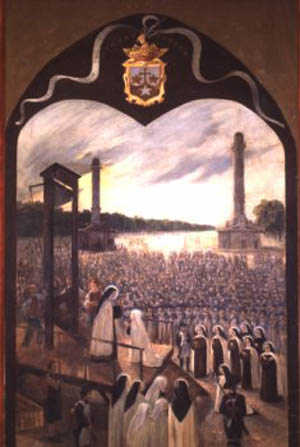 FROM: http://saints.sqpn.com/entries-on-the-scapular/
FROM: http://saints.sqpn.com/entries-on-the-scapular/

Latin:
scapula, shoulder-blade
The scapular forms a part, and now the most important part, of the habit of the monastic orders. Other orders and numerous religious congregations (both male and female) have also adopted the scapular from the monastic orders. It is usually worn over the habit or soutane and consists of a piece of cloth about the width of the breast from one shoulder to the other, and long enough that it almost reaches the feet in front and behind. In the middle of the cloth is the opening for the head, the scapular thus hanging down from two narrow connecting segments resting on the shoulders. Originally the segments were connected by cross pieces under the arms.
This scapular, like the whole monastic habit and the liturgical vestments of the priest, developed from the ordinary clothing of the laity. Just as the stole is the special sign of the priestly dignity and power, the scapular is now the sign of the monk. In the West, in the case of Saint Benedict, the scapular was at first nothing but a work garment or apron such as those used by agricultural labourers. From this developed the special monastic garment to which a hood could be fastened at the back. In fact, the original scapular of the Dominican Order was made so that it covered the head.
Ceremony and Symbolism
Western monastic formulae from the 9th century make no mention of the investment with the scapular. It was only gradually that it became one of the important part of the monastic habit, and later it was solemnly presented during the clothing, and the symbolism of the scapular is emphasized in the formula used during this ceremony. The scapular was often called simply
crux (
cross) due to its shape, and symbolism was introduced accordingly. It was thus natural to term the scapular
jugum Christi (
the yoke of Christ); it was also called
scutum (
shield), as it was laid over the head, which it originally covered and protected with one portion (from which the hood afterwards developed).
The rules of the religious orders expressly required the scapular must be worn, even at night. Carmelites have now a special smaller scapular which they wear at night, and it is likewise prescribed in the Servite Constituion. After Saint Benedict required appropriate dress while sleeping, the scapular became required for Benedictines, and appears to have become a portion of the night clothing of all monks.
Third Order Use
In the early Middle Ages, many lay people had already joined the Benedictine Order as oblates, and often received the entire monastic habit which they wore either constantly, or at least during Divine Service. It was a great grace and privilege to die and/or be buried in the monastic habit, which was frequently given to the dying or placed on the deceased before burial. The 1891 and 1904 statutes of the Benedictine Oblates states that "Oblates may be buried in the black habit of the order, with scapular and girdle, wherever the conditions allow the fulfilment of this pious wish". By the Decree of the Sacred Congregation of Bishops and Regulars in 1616, the Bizzoche who lived in the houses of relatives could wear the tertiary habit, but without veil, pectorale, and scapular. Later, the wearing of the special habit of an order became unusual, and constantly wearing one was regarded as a privilege.
Gradually the most distinctive article of the monastic habit, the scapular, was given in an ever smaller form. Eventually the third orders for the laity, such as those of the Franciscans, Servites and Dominicans, began to wear as their special badge and habit a "large" scapular, consisting essentially of two segments of woollen cloth (about 4.5 by 2.5 inches, although no particular length or breadth is prescribed) connected with each other by two strings or bands. The best known scapular is that of the Third Order of Saint Francis, or, as it is simply called, the
Scapular of Saint Francis; it is brown, grey, or black in colour and generally has on one of the woollen segments the image of Saint Francis and on the other that of the little church of Portiuncula. For these large scapulars, the same general rules hold good as described in detail below in the case of the small scapulars. It is especially necessary that persons who desire to share in the indulgences and privileges of the third orders shall wear the scapulars constantly. However, the Congregation of Indulgences expressly declared on 30 April 1885 that the wearing of the scapulars of smaller form and of the same size as those of the confraternities entitled one to gain the indulgences of the third order...










